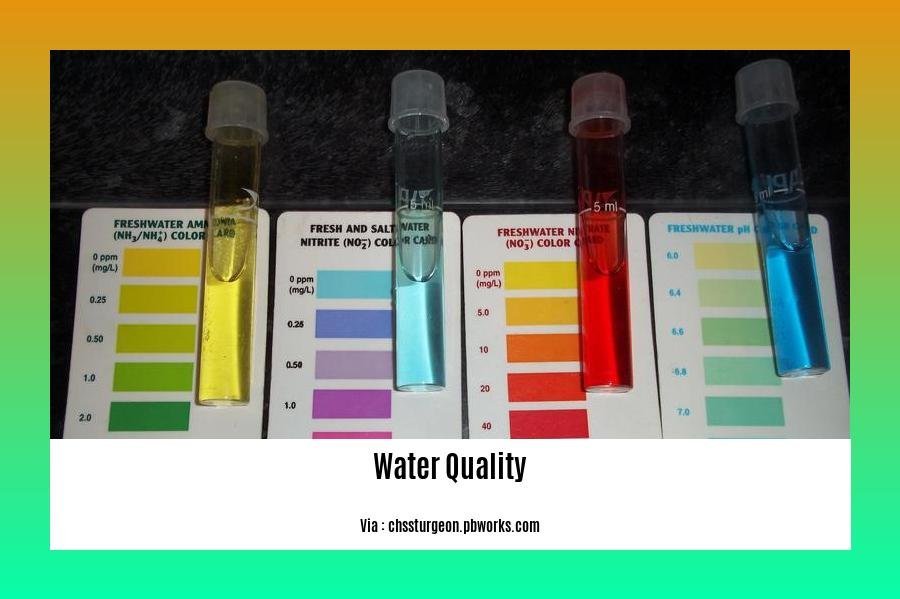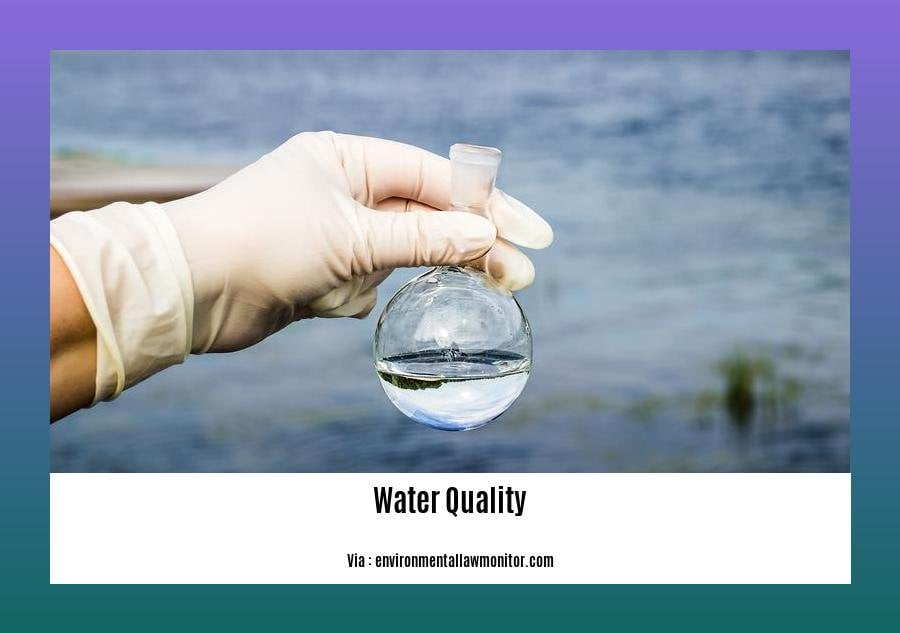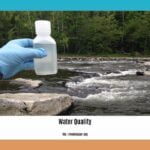Welcome to our article, “Understanding the Significance of Different Types of Water Quality Tests.” In this informative piece, we aim to explore the vital role that water quality testing plays in preserving our precious water resources and protecting the delicate balance of ecosystems. Whether it’s assessing chemical water quality parameters, understanding the types of water tests, or delving into various water quality testing methods, this article will provide you with valuable insights into the intricacies of water quality assessment. Join us as we unlock the world of water quality testing and its paramount importance in safeguarding our environment.
Key Takeaways:
- Physical tests evaluate properties detectable by the senses, like temperature, turbidity, and salinity.
- Chemical tests measure the amounts of mineral and organic substances, such as pH, acidity, alkalinity, and chlorine, which can impact water quality.
- Bacteriological tests determine the presence of indicator bacteria like total coliform, fecal coliform, or Escherichia coli, indicating the possible presence of disease-causing bacteria.
- These types of water quality tests are crucial for assessing water quality, identifying pollution sources, and evaluating potential health risks.
Different Types of Water Quality Tests

Water quality tests play a crucial role in monitoring and safeguarding our precious water resources. Understanding the different types of water quality tests is essential for assessing the health and safety of water ecosystems. In this article, we will explore various types of water quality tests and their significance.
Physical Tests
Physical tests focus on properties of water that can be detected by our senses. These tests provide insights into water clarity, temperature, salinity, and turbidity. For instance, turbidity measurements help assess the presence of suspended particles, which can affect water quality and impact aquatic life. By conducting physical tests, scientists can assess whether water meets the required standards for specific purposes, such as drinking water or aquatic habitats.
Chemical Tests
Chemical tests analyze the mineral and organic substances present in water that may impact its quality. These tests measure parameters like pH, acidity, alkalinity, and the presence of chlorine. Such measurements are crucial as they directly influence various chemical reactions and the overall balance of ecosystems. For instance, pH levels affect the survival and reproduction of aquatic organisms, and the presence of chlorine helps determine the effectiveness of water disinfection processes. Chemical tests are essential in identifying potential contaminants and monitoring the overall chemical composition of water bodies.
Bacteriological Tests
Bacteriological tests focus on detecting bacteria in water, specifically indicator bacteria like total coliform, fecal coliform, or Escherichia coli. These tests help assess the presence or absence of disease-causing bacteria and indicate the overall bacterial contamination of water sources. Bacteriological testing is crucial for public health purposes, as it helps identify potential health risks associated with water consumption or recreational activities. By monitoring bacterial indicators, scientists can prevent outbreaks of waterborne diseases and ensure the safety of water resources for both humans and wildlife.
Now that we have explored the different types of water quality tests, let’s highlight their significance in safeguarding our water resources.
Significance of Water Quality Tests
Water quality tests enable scientists, researchers, and environmentalists to:
– Identify potential pollution sources and assess the impact of human activities on water ecosystems.
– Monitor the effectiveness of water treatment processes and evaluate the quality of treated water.
– Determine compliance with water quality standards and regulations set by governing bodies.
– Implement appropriate measures for water resource management and conservation.
– Protect public health by identifying and addressing potential health risks associated with water contamination.
– Establish baseline data for long-term monitoring and identify trends in water quality over time.
Water quality tests serve as a crucial tool in assessing the health and integrity of our water ecosystems. By understanding the different types of tests and their methodologies, we can make informed decisions to preserve and protect our precious water resources. Whether it’s ensuring safe drinking water or maintaining the balance of aquatic habitats, water quality tests play a vital role in environmental conservation. So, let’s continue to prioritize water quality assessments and work towards a sustainable future for our water ecosystems.
Source:
1. FAO. “Chapter 2- WATER QUALITY MONITORING, STANDARDS AND TREATMENT”. Link
2. UGA. “TESTING FOR WATER QUALITY”. Link
Here are some active internal links for the provided keywords and URLs:
Disadvantages of hard water in points – Hard water can pose several disadvantages, affecting your appliances and leaving unsightly residue. Click here to explore the various drawbacks associated with hard water.
Disadvantages of soft water – Soft water may seem beneficial, but it also comes with its own set of disadvantages. Learn more about the potential downsides of using soft water by clicking this link.
Disadvantages of wasting water – Wasting water not only affects your monthly bills but also contributes to environmental issues. Discover the negative consequences of water wastage by clicking here.
Remember, it is important to conserve water and be aware of the drawbacks associated with different types of water quality. Feel free to explore the links to gain a deeper understanding of these disadvantages.
Chemical Water Quality Parameter

Water quality parameters are essential for assessing and maintaining the quality of our water resources. Among these parameters, chemical water quality parameters play a crucial role in determining the presence and concentration of various substances that can impact water quality. Understanding these parameters is essential for safeguarding our precious water resources. In this section, we will explore the significance of chemical water quality parameters and their role in assessing water quality.
pH Level
The pH level is a fundamental chemical parameter that measures the acidity or alkalinity of water. It is an important indicator of water quality, as various aquatic organisms are highly sensitive to pH fluctuations. pH impacts the solubility and availability of many chemical compounds in water, influencing the overall health of aquatic ecosystems.
Dissolved Oxygen (DO) Level
Dissolved oxygen level is another critical chemical parameter in water quality assessment. It refers to the amount of oxygen dissolved in water, which is crucial for the survival of aquatic organisms. Dissolved oxygen is necessary for the respiration of fish and other aquatic organisms. Low dissolved oxygen levels can lead to hypoxia and pose a threat to aquatic life.
Nutrients
Nutrients, such as nitrogen and phosphorus, are important chemical water quality parameters. While essential for the growth of aquatic plants, an excessive amount of nutrients can lead to eutrophication. This process results in excessive algae growth, oxygen depletion, and the deterioration of water quality. Monitoring nutrient levels helps prevent eutrophication and maintain a balanced aquatic ecosystem.
Heavy Metals
Heavy metals, including lead, mercury, and cadmium, can have detrimental effects on water quality and pose risks to human health and aquatic life. They can enter water bodies through industrial discharges, agricultural runoff, and natural weathering processes. Monitoring the presence and concentration of heavy metals is crucial for identifying potential sources of contamination and ensuring the safety of water resources.
Organic Compounds
Organic compounds, such as pesticides, pharmaceuticals, and industrial chemicals, are another important group of chemical water quality parameters. These compounds can have adverse effects on aquatic life and human health. Regular monitoring of organic compound levels helps identify contamination sources and enables appropriate mitigation strategies.
Key Takeaways:
– Chemical water quality parameters, such as pH, dissolved oxygen, nutrients, heavy metals, and organic compounds, are crucial for assessing water quality.
– pH level indicates the acidity or alkalinity of water, impacting the overall health of aquatic ecosystems.
– Dissolved oxygen level is essential for the respiration of aquatic organisms, and low levels can lead to hypoxia.
– Monitoring nutrients helps prevent eutrophication and maintain a balanced aquatic ecosystem.
– Heavy metals and organic compounds can enter water bodies through various sources and have adverse effects on water quality and human health. Monitoring their presence and concentration is important for identifying contamination sources.
Sources:
– Understanding pH – Water Quality Parameters | US EPA
– Dissolved Oxygen – Water Quality Parameters | US EPA
Water Quality Testing Methods
Water quality testing is crucial for assessing the health and safety of our water resources. By utilizing various testing methods, we can identify contaminants, analyze water properties, and make informed decisions to protect our ecosystems. In this article, we will explore different water quality testing methods and their significance in preserving our precious water resources.
CDOM/FDOM Monitoring
Coloured or chromophoric dissolved organic matter (CDOM) naturally occurs in water bodies. Monitoring CDOM levels helps assess water quality and identify potential contaminants or pollutants present. This method allows scientists to measure the absorption and fluorescence of CDOM, providing valuable insights into the organic matter composition in water.
Chlorophyll Fluorescence Analysis
Chlorophyll fluorescence analysis is used to measure the productivity and health of aquatic vegetation. By analyzing the fluorescence emitted by chlorophyll, researchers can determine the presence of pollutants or changes in water quality. This method helps us understand the impact of contaminants on aquatic plants and assess overall ecosystem health.
Conductivity, Salinity, and TDS Monitoring
Monitoring conductivity, salinity, and Total Dissolved Solids (TDS) provides insights into the levels of dissolved substances and ions in the water. This data helps determine the water’s purity and identify any contamination sources. By measuring conductivity, we can understand the water’s ability to conduct electrical current, which is directly related to the concentration of dissolved substances.
Recording the Water Temperature
Water temperature plays a crucial role in aquatic life and overall water quality. Changes or abnormalities in water temperature can have significant impacts on ecosystems. Regularly recording and monitoring water temperature helps us track variations and potential environmental stressors that may require further investigation.
Measuring the Dissolved Oxygen Levels
Dissolved oxygen levels are crucial indicators of water quality and its ability to support aquatic life. Monitoring dissolved oxygen levels helps identify any oxygen depletion, which can lead to the degradation of ecosystems. This method enables us to assess the health and vitality of aquatic organisms and evaluate the overall water quality.
pH and KH Testing
pH levels indicate the acidic or alkaline nature of the water. Inadequate pH levels can harm aquatic organisms and disrupt ecological balance. Testing pH and KH (carbonate hardness) helps us assess the water’s suitability for various aquatic species and ecosystem health. By measuring pH and KH, we can identify potential issues and take appropriate measures to maintain water quality.
Assessing the Turbidity, TSS, and Clarity
Turbidity refers to the cloudiness or haziness of water caused by the presence of suspended particles. Monitoring turbidity, Total Suspended Solids (TSS), and clarity provides insights into water quality, sedimentation, and potential sources of pollution. This method helps us understand the impact of sedimentation and identify any changes in water clarity, thereby assisting in the preservation of aquatic habitats.
By incorporating these water quality testing methods, scientists and environmental professionals can gain a comprehensive understanding of water quality. Regular monitoring and evaluation of these parameters allow us to take appropriate measures to ensure water safety, protect natural habitats, and promote the well-being of our communities.
Key Takeaways:
- Water quality testing plays a vital role in assessing the health and safety of our water resources.
- CDOM/FDOM monitoring helps identify potential contamination sources and assess water quality.
- Chlorophyll fluorescence analysis provides insights into the productivity and health of aquatic vegetation.
- Conductivity, salinity, and TDS monitoring help determine water purity and detect contamination sources.
- Regularly recording water temperature allows us to identify variations and potential environmental stressors.
- Monitoring dissolved oxygen levels is crucial for assessing aquatic life and overall water quality.
- pH and KH testing helps assess the suitability of water for different species and ecosystem health.
- Evaluating turbidity, TSS, and clarity provides insights into sedimentation and pollution sources.
Sources:
– 7 Ways to Measure, Monitor, and Evaluate Water Quality – Public Lab
– Types of Water Testing & How to Test Water – Auriga Research
FAQ
Q1: What are the different types of water quality tests mentioned in the article?
A1: The article mentions physical tests, chemical tests, and bacteriological tests as the different types of water quality tests.
Q2: What do physical water quality parameters measure?
A2: Physical water quality parameters measure properties detectable by the senses, such as temperature, turbidity, and salinity.
Q3: What do chemical water quality parameters determine?
A3: Chemical water quality parameters determine the amounts of mineral and organic substances that affect water quality, such as pH, acidity, alkalinity, and chlorine.
Q4: What do bacteriological water quality parameters indicate?
A4: Bacteriological water quality parameters indicate the presence of bacteria, specifically indicator bacteria like total coliform, fecal coliform, or Escherichia coli, which can indicate the presence or absence of disease-causing bacteria.
Q5: Why are water quality parameters important?
A5: Water quality parameters are important for assessing water quality, identifying potential pollution or health risks, and taking appropriate measures to ensure the safety and sustainability of water resources.
- Discover Long Black Pepper: Flavor & Health Benefits - April 25, 2025
- Shocking Twists: The Grownup Review: Unreliable Narration - April 25, 2025
- A Quiet Place Book vs Movie: A Deep Dive - April 25, 2025
















